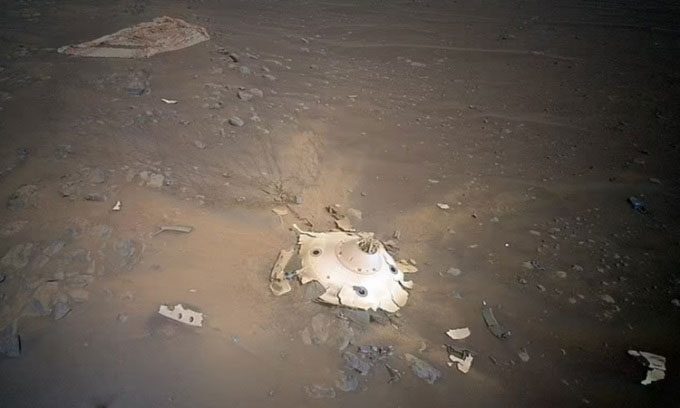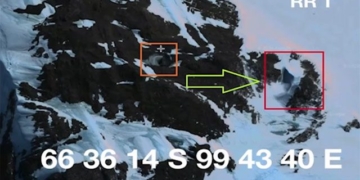Although humans have never set foot on Mars, artificial debris from landers and rovers continues to accumulate on the Red Planet.
A new map reveals the locations of debris from landing vehicles on Mars over the past 53 years, including the inactive Ingenuity helicopter from NASA, as reported by Mail on January 31. This debris includes metallic landing equipment, heat shields, used parachutes, broken rotor blades, nose cones, and even fabric mesh. Cagri Kilic, an aerospace engineering professor at West Virginia University, estimates that the total amount of human waste on Mars is approximately 7,119 kg, equivalent to the weight of an adult African elephant.

The parachute and conical shield protecting the Perseverance rover during landing. (Photo: NASA).
Examples of human waste on the Red Planet include Russia’s Mars 2 lander, which became the first artificial object to touch the surface of Mars when it fell in May 1971. Beagle 2, a spacecraft from Russia, landed on Mars in December 2023 but was subsequently lost. The most recent addition to the list of vehicles is NASA’s Ingenuity helicopter, which could no longer fly after one of its rotor blades broke on January 18. Due to the damaged rotor and lack of wheels, the helicopter is now stranded in place, unable to move, although it remains in contact with the ground control team.
These vehicles represent significant achievements in reaching a planet that is 225 million kilometers from Earth, with many instruments conducting valuable scientific experiments upon landing. Professor Alice Gorman, a space archaeologist at Flinders University in Australia, likens the inactive landers to historical records of humanity’s connection with Mars. “Ingenuity demonstrates how far the technology we need to adapt to life on another planet can go,” Gorman stated.
However, as these machines cease to function, they turn Mars into a junkyard. Dr. James Blake, a space debris researcher at the University of Warwick, believes that future missions to Mars should be designed with sustainability as a priority. This includes designing spacecraft that do not shed parts upon landing on Mars or that can return to Earth at the end of their missions. Manned missions to Mars in the coming decades may be able to land on the planet and collect space debris.
Including Ingenuity, nearly 20 landers have reached the Martian surface through successful soft landings or hard crashes. Currently, many of the landers that have fallen to the ground exist as debris or even burn marks, evidence of their successful journey to Mars before crashing in the final stages. One example is NASA’s Mars Polar lander, which crashed while attempting to land in the southern polar region in December 1999. Images of the crash site released in 2005 show the parachute and a patch of Martian soil burned by rocket engines. A similar example is Italy’s Schiaparelli lander, which struck the surface of Mars at a speed of 306 km/h in October 2016, leaving behind a dark spot surrounded by the lander’s heat shield and parachute.
Other spacecraft that successfully landed and completed their missions have also left traces during their operational periods. NASA’s Opportunity rover operated from 2004 until mid-2008, creating a trail of debris as it moved across the Red Planet. This 157 kg rover is now stuck in Martian soil. It transmitted a photo of its heat shield back in 2004, along with debris scattered across the surface for several kilometers. According to Kilic, the majority of the rover remains intact, and space agencies regard it as a historical monument rather than waste.




















































